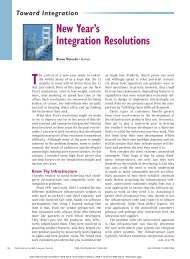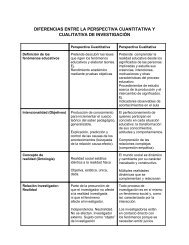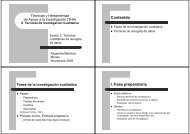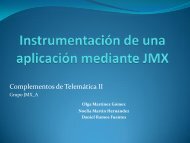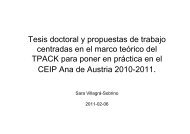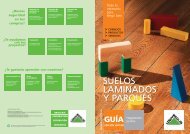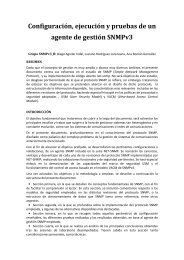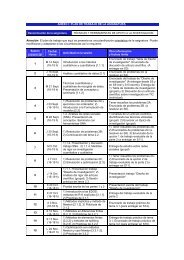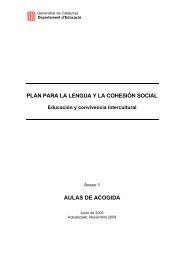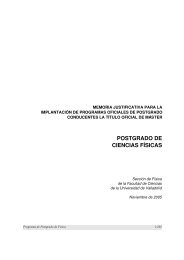Research Questions and Hypotheses
Research Questions and Hypotheses
Research Questions and Hypotheses
You also want an ePaper? Increase the reach of your titles
YUMPU automatically turns print PDFs into web optimized ePapers that Google loves.
164 Designing <strong>Research</strong><br />
Quantitative Methods 165<br />
Table 8.5 (Continued)<br />
Type of Threat to Infernal<br />
Validity<br />
Compensatoryiresentful<br />
demoralization<br />
Compensatory rivairy<br />
Testing<br />
Instrumentation<br />
SOURCE: Adapted from Creswell (2008).<br />
Description of Threat<br />
The benefits of an<br />
experiment may be<br />
unequal or resented<br />
when only the<br />
experimental group<br />
receives the treatment<br />
(e.g., experimental group<br />
receives therapy <strong>and</strong> the<br />
control group receives<br />
nothing).<br />
Participants in the control<br />
group feel that they<br />
are being devalued,<br />
. as cornpared to the<br />
experimental group,<br />
because they do not<br />
experience the treatment.<br />
Participants become<br />
familiar with the outcome<br />
measure <strong>and</strong> remember<br />
responses for tater testing.<br />
The instrument changes<br />
between a pre-test <strong>and</strong><br />
post-test, thus impacting<br />
the scores on the<br />
outcorne.<br />
In Response, Actions the<br />
<strong>Research</strong>er Can Take<br />
The researcher can<br />
provide benefits to both<br />
groups, such as giving<br />
the control group the<br />
treatment after the<br />
experiment ends or giving<br />
the control group some<br />
different type of<br />
treatment during the<br />
experiment.<br />
The researcher can take<br />
steps to create equolity<br />
between the two groups,<br />
such as reducing the<br />
expectations of the<br />
control group.<br />
The researcher can have<br />
a longer time interval<br />
between administrations<br />
of the outcome or use<br />
different items on a later<br />
test than were used in an<br />
earlier test.<br />
The researcher can use<br />
the same instrument for<br />
the pre-test <strong>and</strong> post-test<br />
measures.<br />
Table 8.6 Types of Threats to External Validity<br />
Types of Threats to<br />
Extemal Validity<br />
Description of Threat<br />
In Response, Actions the<br />
<strong>Research</strong>er Can Take<br />
Interaction of selection Because of the narrow The researcher restricts<br />
<strong>and</strong> treatment characteristics of claims about groups to<br />
participants in the which the results cannot<br />
experiment, the researcher be generalized. The<br />
cannot generalize to researcher conducts<br />
individuals who do not additional experiments<br />
have the characteristics of with groups with different<br />
participants.<br />
characteristics.<br />
Interaction of setting <strong>and</strong> Because of the The researcher needs<br />
treatment characteristics of the to conduct additional<br />
setting of participants experiments in new<br />
in an experiment, a settings to see if the same<br />
researcher cannot results occur os in the<br />
generalize to individuals initial setting.<br />
in other settings.<br />
Interaction of history <strong>and</strong> Because results of an The researcher needs to<br />
treatment experiment are time- replicate the study at<br />
bound, a researcher later times to determine if<br />
cannot generalize the the same results occur as<br />
results to past or future in the earlier time.<br />
situations.<br />
• -<br />
Discuss how you plan to address the threat in the design of your<br />
experiment.<br />
Cite references to books that discuss the issue of threats to validity,<br />
such as Cook <strong>and</strong> Campbell (1979); Creswell (2008); Reichardt <strong>and</strong> Mark<br />
(1998); Shadish, Cook, & Campbell (2001); <strong>and</strong> Tuckman (1999).<br />
power or the violation of statistical assumptions. Threats to construct<br />
validity occur when investigators use inadequate definitions <strong>and</strong> measures<br />
of variables.<br />
Practica! research tips for proposal writers to address validity issues<br />
are as follows:<br />
Identify the potential threats to validity that may arise in your study.<br />
A separate section in a proposal may be componed to advance this threat.<br />
Define the exact type of threat <strong>and</strong> what potential issue it presents to<br />
your studv.<br />
The Procedure<br />
A proposal developer needs to describe in detail the procedure for conducting<br />
the experiment. A reader should be able to underst<strong>and</strong> the design<br />
being used, the observations, the treatment, <strong>and</strong> the timeline of activities.<br />
Discuss a step-by-step approach for the procedure in the experiment.<br />
For example, Borg <strong>and</strong> Gal! (1989, p. 679) outlined six steps typically used<br />
in the procedure for a pre-test—post-test control group design with matching<br />
participants in the experimental <strong>and</strong> control groups:<br />
1. Administer measures of the dependent variable or a variable closely<br />
correlated with the dependent variable to the research participants.



